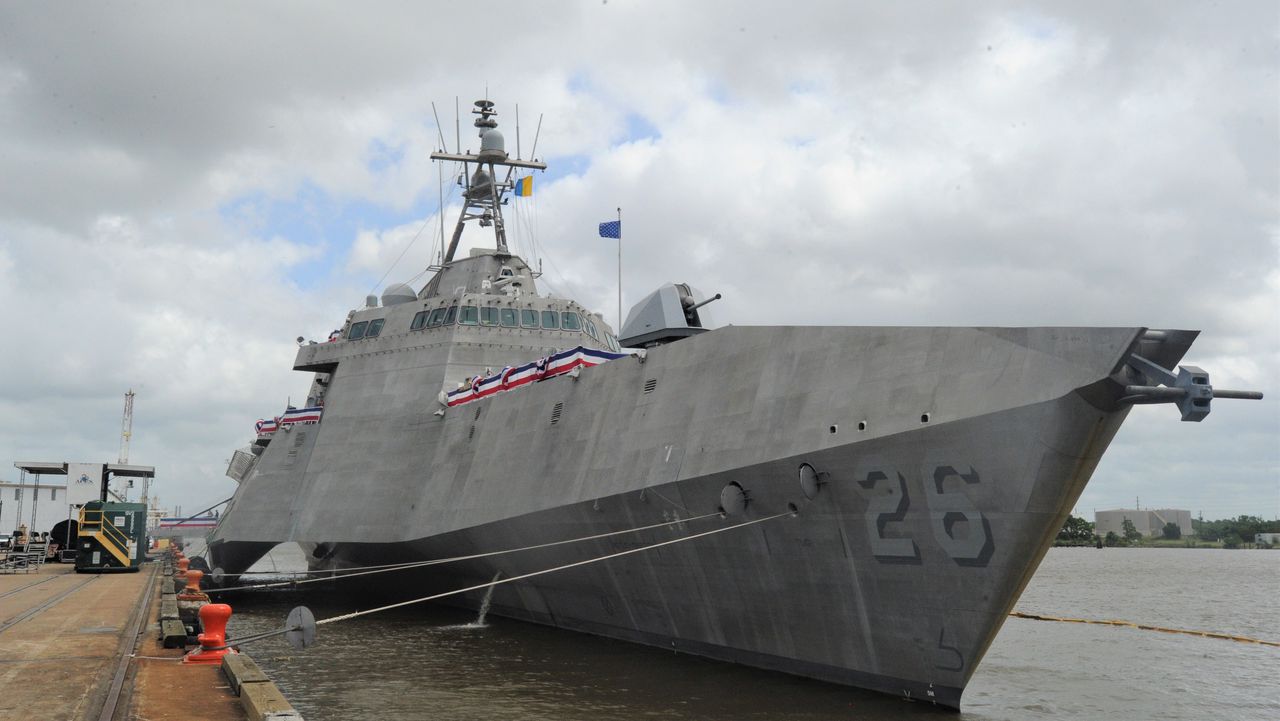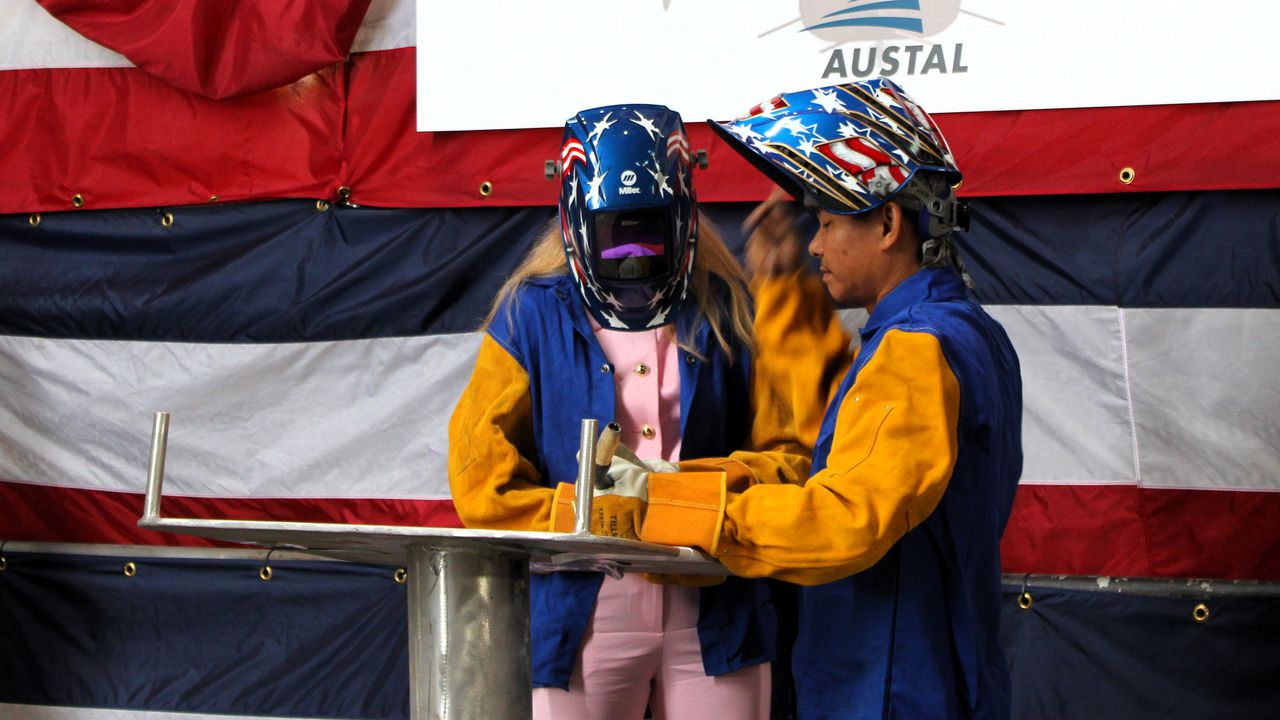Austal USA lays keel for last LCS, the ship âthat made the companyâ
Austal USA celebrated the symbolic keel-laying Friday on what likely will be the last Littoral Combat Ship to enter U.S. Navy service, the beginning of the end for an ambitious, troubled, oft-criticized class that “made the company.”
LCS-38, the 19th LCS built in Mobile and the last of the angular trimarans in the Independence class, will become the USS Pierre. When it does so, it’ll be greeted by expectations somewhat lower than those that led to its conception. And it’ll voyage into geopolitical seas different than those it was designed for.
But none of those concerns registered much at Friday’s ceremony, an occasion attended by an exuberant delegation including the mayor of Pierre, S.D., Steve Harding, and both of South Dakota’s senators, one of whom is the father of the ship’s sponsor. This was an occasion to celebrate the class, the ship and the shipyard that produced it.
Sens. John Thune and Mike Rounds waxed eloquent about South Dakota’s tradition of military service, including its representation among naval ships. (Of note: The World War II battleship USS South Dakota, BB57, was a sister ship to the USS Alabama, which sits a stone’s throw from the Austal USA yard. The South Dakota was the most decorated battleship of the war, according to the American Legion. Also, people from Pierre pronounce it “pier.”)
Sen. Rounds said that as a member of the House Armed Services Committee he had a clear message to share: “We need to grow this industry.”
“Without a strong shipbuilding industry, our nation is not safe,” he said. “We need more ships, we need them in a very short order of time, and we’re going to need more than what we can produce with the equipment that’s available to us. So be prepared, because you’re going to be asked to do a whole lot more in the defense of our country over the next several years.”
“There’s no mistaking the fact that the threats beyond our shores are becoming more sophisticated and dynamic,” said Sen. Thune. “When Pierre joins the fleet, she will give our combatant commanders an agile platform that expands their ability to establish a presence and project power.”
It’s always been a little questionable how one lays the keel of a trimaran that’s welded up from premade modules. Howard Berkof, Littoral Combat Ship deputy program manager for the Navy, tackled the question head-on.
“Today’s keel-laying marks the ceremonial beginning of the ship’s life,” he said. “For Pierre, the modules behind us are the modern shipbuilding equivalent of her strong keel. Shipbuilding methods have changed over time but the spirit of the keel-laying ceremony endures.
“This moment marks the beginning of a relationship with the ship and her crew that will span decades during Pierre’s service to the fleet and our nation,” Berkof said.
Austal USA welder Hon Tran, right, helps Larissa Thune Hargens, daughter of South Dakota Sen. John Thune, weld her initials onto a plate during the keel-laying ceremony for the future USS Pierre.Lawrence Specker | [email protected]
A short time later Larissa Thune Hargens, daughter of Sen. Thune, donned welding gear. With the help of Austal welder Hon Tran, she blazed her initials onto a steel plate that will be fixed inside the ship. “I hereby declare the keel of the future USS Pierre has been truly and fairly laid,” she proclaimed afterward, completing the ritual.
Larry Ryder, Austal USA’s vice president for business development and external affairs, said it was the shipyard’s 33rd keel-laying for a Navy vessel. “We appreciate the confidence the Navy has in us and understand the responsibility that has been bestowed upon us,” he said. “We are honored and take great pride in building these warships knowing they play a vital role in protecting the nation’s freedom.”
A class of its own
One uncomfortable truth about the Littoral Combat Ships has been obvious for a long time now: The class never lived up to what was an extremely ambitious concept. The sales pitch wasn’t just that they would be really fast ships that could operate in coastal regions too shallow for the heavyweights. An equally big selling point was that these leopards would be able to change their spots. In theory, an LCS rigged for surface combat would be able to zip into port, swap out a mission module and a few specialist personnel, then zip back out ready to work as a minesweeper or an anti-submarine ship.
That vision melted away over the years. The Navy eased round to the idea that the ships would be flexible as a class, but it would be better for each individual ship to have a set specialty. But the critical mission modules suffered from slow development compounded by a lack of funding, as detailed in a Feb. 2022 report from the Government Accountability Office that said the Navy still had a long way to go on that front. (“Without a comprehensive plan to address deficiencies, perform adequate testing of the mission modules, and implement lessons learned from completed deployments, the LCS will remain at risk of being unable to operate in its intended environment. Further, gaps between desired and demonstrated capabilities have substantial implications for the Navy’s ability to deploy the LCS as intended.”)
Meanwhile, both the Independence-class ships built in Mobile and the Freedom-class ships built in Wisconsin have suffered problems with their complicated high-speed drivetrains, among other things. Three of the first four ships (including two built in Mobile) already have been decommissioned, basically written off as test mules.
Austal generally has fared better than Freedom-class builders Lockheed Martin and Marinette Marine. The Freedom class has a thorny powertrain issue that has hamstrung the fleet while a difficult and expensive fix is worked out. In recent years, Navy planners have presented several plans to decommission Littoral Combat Ships sooner rather than later, and these plans have tended to target the Freedom class more heavily than the Independence class. In spring 2022, it proposed mothballing nine of them “amid rumors the Navy might try to decommission the entire Freedom class,” according to www.defensenews.com.
It has been tough for the Freedom class. In April, the future USS Cleveland, the last of its kind, bashed into a tugboat as it was launched, adding injury to insult.
The Independence class has fared better, by comparison. Austal cranked out more ships faster, meaning it ultimately will build 19 ships to the other guys’ 16. But the Independence class has had its own problems. Managing corrosion on the aluminum hull was an early concern; more recently the Navy has grappled with stress cracks in certain areas of the hull above the waterline, leading to an edict that at least some of the Independence class ships must keep their speed down, at least in certain conditions. So even the ships’ speed, a core asset, comes with an asterisk.
One upshot is that the Littoral Combat Ships remain a political football, as they have been since Day 1. In April, reports emerged that the Navy wanted to decommission and maybe sell off two of the Independence-class ships and four from the Freedom class. Once again, the Navy was signaling that it wanted to get out of the LCS business long before the ships have served out their intended 25-year lifespan. (The six ships in question are between 3 and 8 years old.)
On Monday, June 12, the U.S. Naval Institute News reported that the seapower and projection forces subcommittee of the House Armed Services Committee appeared OK with this: it didn’t object to plans to decommission the USS Jackson and the USS Montgomery, both of the Independence class. The subcommittee did object to some other non-LCS decommissioning plans.
The Naval Institute News report quoted an unnamed senior Republican aide as saying, “You’ll see that throughout our bill, especially with the Pacific Deterrence Initiative – divesting from some of these old legacy platforms that are not survivable in the Indo-Pacific region against a very capable adversary. We’re really taking a hard look and making some tough choices on things we don’t think we need anymore, as we’re confronting a 21st-century military.”
But just a couple of days later, the Naval Institute News reported that the House Appropriations Committee’s defense subcommittee had moved to block the Navy from decommissioning any Littoral Combat Ships. The report dryly noted that “This sets up a disagreement with authorizers over ship decommissionings.” That’s a reminder of the politically complex process involved. With one hand, Congress hammers out a National Defense Authorization Act that includes the hardware the military is to get, with the other it hammers out appropriations bills that specify what will be paid for. They don’t always line up, and we’re still early in the process for the 2023-24 budget cycle.

Independence-class Littoral Combat Ships are distinguished by their futuristic trimaran design. LCS 26, the USS Mobile, was commissioned in 2021.Lawrence Specker | [email protected]
Bashing the LCS has been a cottage industry for 20 years now, and the slams often have been harsh. In July 2022, Politico published a story with the backhanded headline, “20 years later, the Navy says its littoral combat ships (kind of) work.” In it, Rep. Jackie Speier of California is quoted as saying, “We all know what lemon cars are. We have a fleet of lemon LCS ships … We have spent billions of dollars on this fleet when they have no capability to help us deal with what our largest threat is, which is that of China and Russia. The only winners have been the contractors on which the Navy relies for sustaining these ships.”
In January, specialist news site www.Naval-technology.com published a story headlined “Was the US Navy’s Littoral Combat Ship a mistake?” Despite the tone of the headline, it (like the Politico story) acknowledged that there have been some gains from the program. For example, “It should not be forgotten that the LCS variants have, aside from operational taskings when available, served as useful test platforms for a variety of technologies, including uncrewed mine countermeasure payloads, that will go on to serve as a backbone of the USN in the future.”
The Navy also has gradually figured out ways to use the ships it has, and at least some of them have been toughened up with additional firepower. A Congressional Budget Office report observed that Littoral Combat Ships do some of the same routine things that other relatively small warships do: “patrol sea lanes, provide an overseas presence, and conduct exercises with allies.”
It’s not the LCS’s fault that the world changed on it. Early supporters such as George W. Bush-era Defense Secretary Donald Rumsfeld envisioned it as being perfect for a era where superpower relations were calm and the U.S. Navy needed to mount nimble responses to smaller regional threats. But China has become a bigger headache, raising the prospect of heavyweight navies going toe-to-toe. A relatively small, lightly armed aluminum vessel doesn’t necessarily fare well in such a scenario.
Politico cited a Navy report saying that “LCS has military value… [but] it has less military value than other platforms if employed in a high-end fight with China, in the Pacific.”
The emerging expectation is that the LCS will continue to be an active part of the fleet, just not as big a part as had been planned, and maybe for not as long. The numbers vary depending on who’s doing the guessing. And who knows how the geopolitical tides will shift in the next decade.
“The role of the LCS has already changed, and it will change again a couple of times before it leaves the fleet entirely,” analyst Craig Hooper told www.naval-technology.com.
LCSs will be used in the development of unmanned programs and Intelligence, Surveillance and Reconnaissance technologies, he said. “It is a platform caught in the center of a number of emergent technologies and platforms, yes, but, at the end of the day, I think there’s a good bit of use in having basic manned platforms out there, in the islands of the Pacific, doing engagement and various ISR tasks.”
‘It’s a little bittersweet’
Over the years, Austal executives have rigorously avoided comment on the political tussles around the LCS, such as the debate over early decommissioning. And they’ve consistently deferred to the Navy on operational questions. Their focus, they’ve always said, has been to build the ships the Navy ordered and to deliver them on time and on budget.
Seen from that compartmentalized perspective, the keel-laying for LCS-38 is nothing but a win.
Austal USA and Mobile owe a lot to the program. It was the primary driver as Austal grew to become the city’s largest industrial employer, with a workforce that crested at over 4,000 people and two giant assembly bays that became fixtures of the waterfront skyline. It continued long enough – just barely – for Austal to secure a more diversified future, with a mix of major programs including steel construction.
“It made the company, so there’s that,” said Larry Ryder.

Larry Ryder, Austal USA’s vice president for business development and external affairs, speaks during a keel-laying ceremony for LCS-38, the future USS Pierre. The ceremony for Austal’s last Independence-class Littoral Combat Ship was held on June 16, 2023.Lawrence Specker | [email protected]
Ryder said that while there were some challenges getting the program up and running, “It’s really performing well now.”
“LCS-18, the Charleston, just returned from a 26-month deployment, the longest LCS deployment to date,” Ryder said. “Really positive feedback there. So it’s just good to see that that program is really performing well out in the fleet.”
The Navy likewise has tended to emphasize the positive. In April when it commissioned the Independence-class USS Santa Barbara (LCS-32) and in May when it commissioned the Freedom-class USS Cooperstown, the Department of Defense used the same language to describe the class: “Littoral Combat Ships are fast, optimally-manned, mission-tailored surface combatants that operate in near-shore and open-ocean environments, winning against 21st-century coastal threats. LCS integrate with joint, combined, manned and unmanned teams to support forward-presence, maritime security, sea control and deterrence missions around the globe.”
The class hasn’t received its last bit of fanfare. The Navy will commission LCS-30 as the USS Canberra at a ceremony July 22 in Sidney, Australia. The Navy says it’s the first time it will commission a ship overseas, and that’s especially exciting for Austal USA because its parent company, Austal Ltd., is Australian.
It comes as Australia, the United Kingdom and the United States are moving toward a tighter military alliance, with a particular focus on submarines and an eye on thwarting a more assertive Chinese navy. In the first phase of the program, Australia will acquire three Virginia-class subs from the U.S., while a new “AUKUS” class, named for the three countries, is developed. Austal already is under contract to build modules that will go into Virginia- and Columbia-class subs.
“We’re pretty excited about the opportunities there,” said Ryder.
“I think LCS has still proven useful,” he said. “It was designed for a different era, but the Navy I think has done a pretty good job of putting a little more firepower and survivability in that platform.”
All criticism aside, the LCS got Austal USA where it is today, which seems to be a pretty good place. Ryder said the shipyard is on the verge of a major expansion, with new buildings and 2,000 more jobs.
“It’s kind of sad to see it end production when we really had things figured out, both on the production side and the Navy operationally,” Ryder said. “It’s a little bittersweet, but we’ve got all this growth going on.”
Related:
Austal USA braces for boom: 2,000 new jobs, new facilities to come
